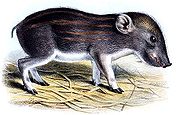
Pygmy Hog
Encyclopedia
Pygmy hog is an endangered species of small wild pig, previously spread across India
, Nepal
, and Bhutan
but now only found in Assam
. The current world population is about 150 individuals or fewer. Recent conservation measures have improved the prospects of survival in the wild of this critically endangered species.
 They are about 55 to 71 cm long and stand at 20-30 cm (7.9-11.8 in.) with a tail of 2.5 cm (1 in.). They weigh 6.6-11.8 kg (14.5-26 lbs). Their skin is dark brownish black and the fur is dark. Piglets are born grayish-pink becoming brown with yellow stripes along the body length. The head is sharply tapered and they have a slight crest of hair on the forehead and on the back of the neck. Adult males have the upper canines visible on the sides of the mouth. They live for about 8 years, becoming sexually mature at 1-2 years. They breed seasonally before the monsoon
They are about 55 to 71 cm long and stand at 20-30 cm (7.9-11.8 in.) with a tail of 2.5 cm (1 in.). They weigh 6.6-11.8 kg (14.5-26 lbs). Their skin is dark brownish black and the fur is dark. Piglets are born grayish-pink becoming brown with yellow stripes along the body length. The head is sharply tapered and they have a slight crest of hair on the forehead and on the back of the neck. Adult males have the upper canines visible on the sides of the mouth. They live for about 8 years, becoming sexually mature at 1-2 years. They breed seasonally before the monsoon
s giving birth to a litter of 3-6 after a gestation of 100 days. In the wild they make small nests by digging a small trench and lining it with vegetation. During the heat of the day they stay within these nests. They feed on roots, tubers, insects, rodents, and small reptiles.
of the genus Porcula (Hodgson
, 1847), but was then regarded as the closest relative of the Eurasian pig Sus scrofa and named Sus salvanius (Oliver, 1980; Oliver & Deb Roy, 1993). New genetic analysis of a large section of mitochondrial DNA supports the original classification of the pygmy hog as a unique genus (Funk et al., 2007). The resurrection of the original genus status and the species name Porcula salvania has been adopted by GenBank
. The species name salvania is after the Sal forests where it was found.
They used to be widespread in the tall, wet grasslands in the southern Himalayan foothills from Uttar Pradesh to Assam, through Nepal and north Bengal
. However, human encroachment has largely destroyed the natural habitat of the pygmy hog by development, agriculture, domestic grazing and deliberate fires. Only one viable population remains in the Manas Tiger Reserve, but even there threats due to livestock grazing, poaching, fire, and tigers persist. The total wild population has been estimated as less than 150 animals and the species is listed as "critically endangered" (Oliver, 1980; Oliver & Deb Roy, 1993; Pigs, Peccaries and Hippos Status Survey and Action Plan, 1993; Narayan, 2006). Their rarity contrasts greatly with the massive population of wild boars (Sus scrofa) in India.
n mammals like the Bengal Tiger
or Indian Rhinoceros
. Local political unrest in the area has also severely hampered effective conservation efforts, but these conflicts have now ceased.
Pygmy hogs were exhibited in the zoos of London and Berlin in the 19th century. However, this captivity was not aimed at conservation, and none of the captive populations survived. Zürich Zoo exhibited pygmy hogs from 1976 to 1978, but all females died. The success of captive breeding dramatically increased after the Pygmy Hog Conservation Programme, PHCP, was established in 1995. The PHCP was established under the umbrella of a formal 'International Conservation Management and Research Agreement' by the Durrell Wildlife Conservation Trust
, the IUCN's Pigs, Peccaries and Hippo Specialist Group, the Forest Department, Government of Assam, and the Ministry of Environment and Forests, Government of India. Durrell Wildlife Conservation Trust
has launched a comprehensive conservation strategy including field status surveys of pygmy hogs and their habitats, behavioural studies, personnel training, local community awareness and assistance programmes and the establishment of a highly successful captive breeding program at the Pygmy Hog Research and Breeding Centre in Assam. Active habitat management has been established and a reintroduction programme has now been launched (Narayan, 2006).
India
India , officially the Republic of India , is a country in South Asia. It is the seventh-largest country by geographical area, the second-most populous country with over 1.2 billion people, and the most populous democracy in the world...
, Nepal
Nepal
Nepal , officially the Federal Democratic Republic of Nepal, is a landlocked sovereign state located in South Asia. It is located in the Himalayas and bordered to the north by the People's Republic of China, and to the south, east, and west by the Republic of India...
, and Bhutan
Bhutan
Bhutan , officially the Kingdom of Bhutan, is a landlocked state in South Asia, located at the eastern end of the Himalayas and bordered to the south, east and west by the Republic of India and to the north by the People's Republic of China...
but now only found in Assam
Assam
Assam , also, rarely, Assam Valley and formerly the Assam Province , is a northeastern state of India and is one of the most culturally and geographically distinct regions of the country...
. The current world population is about 150 individuals or fewer. Recent conservation measures have improved the prospects of survival in the wild of this critically endangered species.
Description and biology

Monsoon
Monsoon is traditionally defined as a seasonal reversing wind accompanied by corresponding changes in precipitation, but is now used to describe seasonal changes in atmospheric circulation and precipitation associated with the asymmetric heating of land and sea...
s giving birth to a litter of 3-6 after a gestation of 100 days. In the wild they make small nests by digging a small trench and lining it with vegetation. During the heat of the day they stay within these nests. They feed on roots, tubers, insects, rodents, and small reptiles.
Taxonomy and systematics
The species was first described as the only memberMonotypic
In biology, a monotypic taxon is a taxonomic group with only one biological type. The term's usage differs slightly between botany and zoology. The term monotypic has a separate use in conservation biology, monotypic habitat, regarding species habitat conversion eliminating biodiversity and...
of the genus Porcula (Hodgson
Hodgson
Hodgson is a surname. In Britain, the Hodgson surname was the 173rd most common in 1881 and the 206th most common in 1998. In the United States of America, Hodgson was the 3753rd most popular surname in the 1990 census.-Origin and Meaning:The surname authority P. H...
, 1847), but was then regarded as the closest relative of the Eurasian pig Sus scrofa and named Sus salvanius (Oliver, 1980; Oliver & Deb Roy, 1993). New genetic analysis of a large section of mitochondrial DNA supports the original classification of the pygmy hog as a unique genus (Funk et al., 2007). The resurrection of the original genus status and the species name Porcula salvania has been adopted by GenBank
GenBank
The GenBank sequence database is an open access, annotated collection of all publicly available nucleotide sequences and their protein translations. This database is produced and maintained by the National Center for Biotechnology Information as part of the International Nucleotide Sequence...
. The species name salvania is after the Sal forests where it was found.
Status
The pygmy hog is the sole representative of Porcula, making the conservation of this critically endangered species even more important as its extinction would result in the loss of a unique evolutionary branch of pigs.They used to be widespread in the tall, wet grasslands in the southern Himalayan foothills from Uttar Pradesh to Assam, through Nepal and north Bengal
Bengal
Bengal is a historical and geographical region in the northeast region of the Indian Subcontinent at the apex of the Bay of Bengal. Today, it is mainly divided between the sovereign land of People's Republic of Bangladesh and the Indian state of West Bengal, although some regions of the previous...
. However, human encroachment has largely destroyed the natural habitat of the pygmy hog by development, agriculture, domestic grazing and deliberate fires. Only one viable population remains in the Manas Tiger Reserve, but even there threats due to livestock grazing, poaching, fire, and tigers persist. The total wild population has been estimated as less than 150 animals and the species is listed as "critically endangered" (Oliver, 1980; Oliver & Deb Roy, 1993; Pigs, Peccaries and Hippos Status Survey and Action Plan, 1993; Narayan, 2006). Their rarity contrasts greatly with the massive population of wild boars (Sus scrofa) in India.
Conservation
Conservation of the species has been hampered due to the lack of public support, unlike that for charismatic South AsiaSouth Asia
South Asia, also known as Southern Asia, is the southern region of the Asian continent, which comprises the sub-Himalayan countries and, for some authorities , also includes the adjoining countries to the west and the east...
n mammals like the Bengal Tiger
Bengal Tiger
The Bengal tiger is a tiger subspecies native to the Indian subcontinent that in 2010 has been classified as endangered by IUCN...
or Indian Rhinoceros
Indian Rhinoceros
The Indian Rhinoceros is also called Greater One-horned Rhinoceros and Asian One-horned Rhinoceros and belongs to the Rhinocerotidae family...
. Local political unrest in the area has also severely hampered effective conservation efforts, but these conflicts have now ceased.
Pygmy hogs were exhibited in the zoos of London and Berlin in the 19th century. However, this captivity was not aimed at conservation, and none of the captive populations survived. Zürich Zoo exhibited pygmy hogs from 1976 to 1978, but all females died. The success of captive breeding dramatically increased after the Pygmy Hog Conservation Programme, PHCP, was established in 1995. The PHCP was established under the umbrella of a formal 'International Conservation Management and Research Agreement' by the Durrell Wildlife Conservation Trust
Durrell Wildlife Conservation Trust
Durrell Wildlife Conservation Trust is a conservation organisation with a mission to save species from extinction.Gerald Durrell founded the Jersey Wildlife Preservation Trust as a charitable institution in 1963 with the Dodo as its symbol...
, the IUCN's Pigs, Peccaries and Hippo Specialist Group, the Forest Department, Government of Assam, and the Ministry of Environment and Forests, Government of India. Durrell Wildlife Conservation Trust
Durrell Wildlife Conservation Trust
Durrell Wildlife Conservation Trust is a conservation organisation with a mission to save species from extinction.Gerald Durrell founded the Jersey Wildlife Preservation Trust as a charitable institution in 1963 with the Dodo as its symbol...
has launched a comprehensive conservation strategy including field status surveys of pygmy hogs and their habitats, behavioural studies, personnel training, local community awareness and assistance programmes and the establishment of a highly successful captive breeding program at the Pygmy Hog Research and Breeding Centre in Assam. Active habitat management has been established and a reintroduction programme has now been launched (Narayan, 2006).
External links
- Entry on "Pygmy Hog - Sus salvanius"; United Nations Environment Programme; World Conservation Monitoring Centre
- ARKive - images and movies of the pygmy hog (Sus salvanius)
- GeneBank - Porcula salvania
- Pygmy hog entry
- The Times (Jan 2007) - This little piggy is back from brink
- Durrell Wildlife Conservation Trust - http://www.durrell.org
- Pygmy hog saved and ready for release, 12th May 2008, Durrell News, Durrell Wildlife Conservation Trust
- Captive-bred pygmy hogs to be relocated; Guwahati, May 12, 2008, The Assam Tribune, India
- Endangered pygmy hogs released into wild, May 09, 2008, By Paul Eccleston, Telegraph, UK
- Rare pygmy hogs head for the wild, By Subir Bhaumik, Monday, 19 May 2008, BBC News, Calcutta, India

